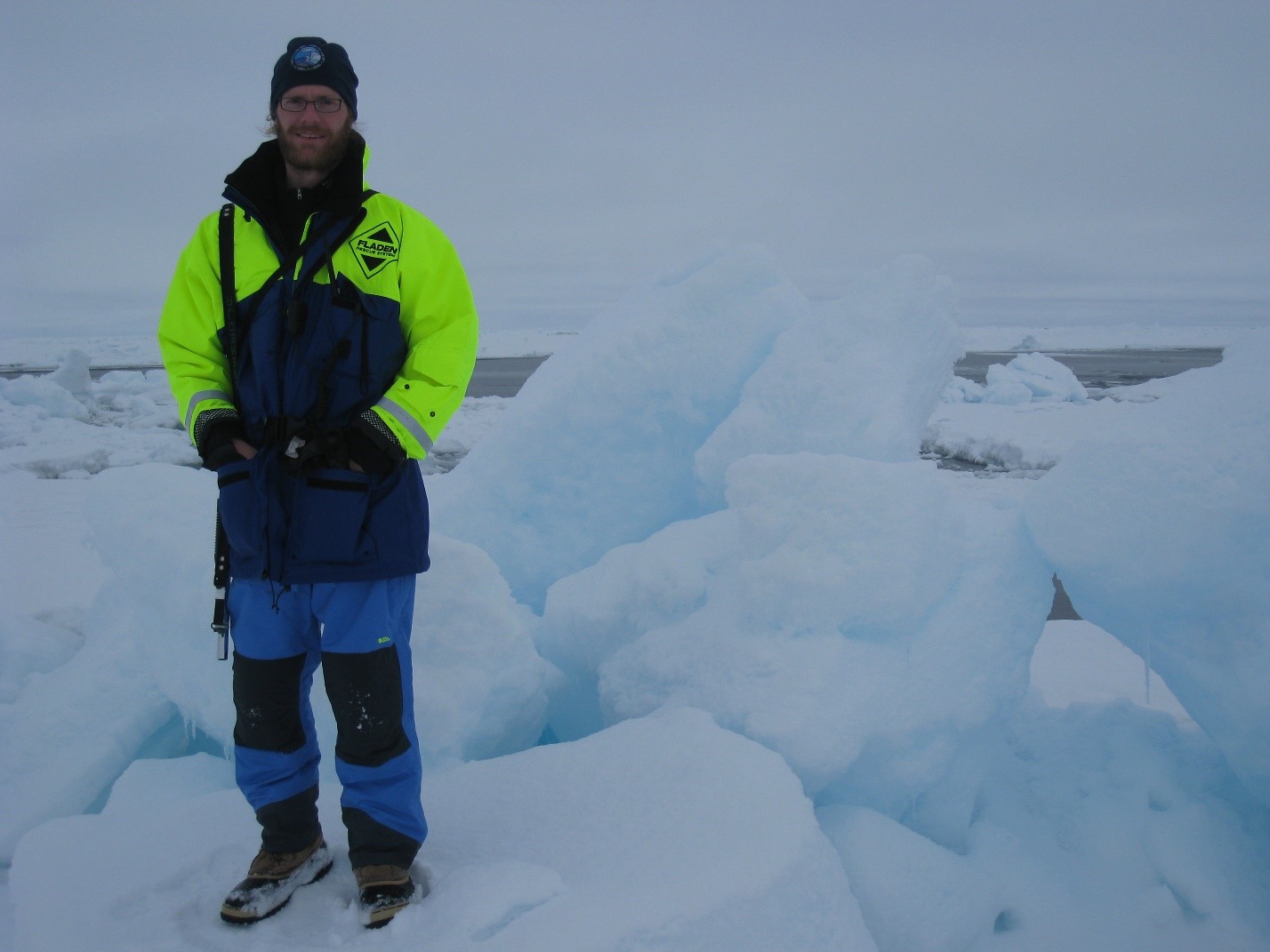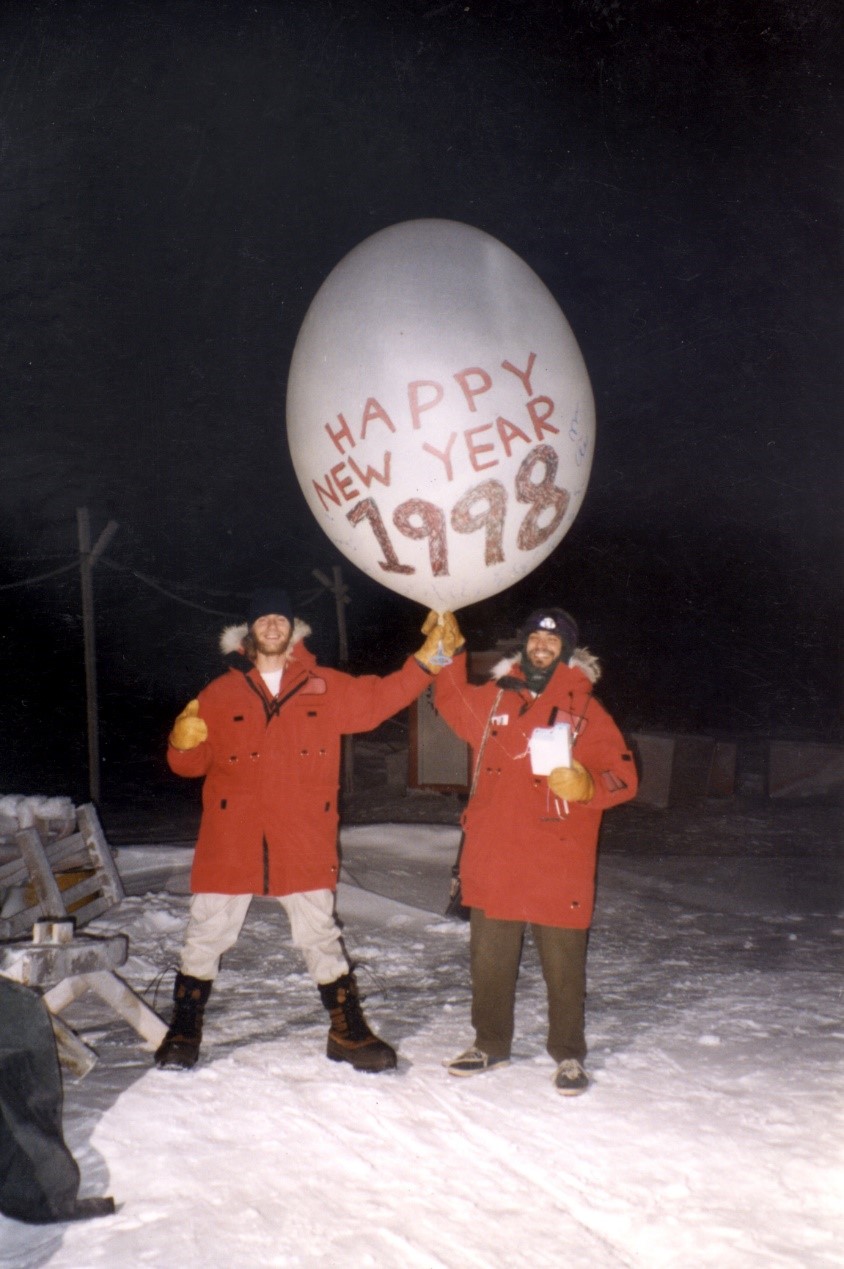UEC Profile: Arctic Messenger
Published: 1 December 2018
Buoyed by a sense of adventure and a passion for clouds, a scientist studies the fragile Arctic and plans a shipborne field campaign adrift for a year in sea ice
This is the 11th article in a series of profiles on members of the ARM User Executive Committee (UEC).

In the fall of 1992, college freshman Matthew Shupe arrived in Tacoma, Washington, from his hometown of Moscow, Idaho. With him was a gift from his high school years—“a curiosity about everything,” he says.
That was at the University of Puget Sound (B.S., summa cum laude, 1997, chemistry and mathematics). All these years later, Shupe still exercises that sense of wonder as a cloud scientist with a special interest in the icy, fragile regions around the North Pole.
“The Arctic is a really important messenger for climate and climate change,” he says. “Bringing people into that environment helps connect them to the whole concept of a climate system and the balances that are playing out.”
Today, Shupe is a senior research scientist at the Cooperative Institute for Research in Environmental Sciences (CIRES) in Boulder, Colorado. CIRES is a joint institute between the University of Colorado and the Earth System Research Laboratory (ESRL), an arm of the National Oceanic and Atmospheric Administration (NOAA).
Among his many outside professional commitments, he is a member of the User Executive Committee (UEC) at the Atmospheric Radiation Measurement (ARM) user facility, funded by the U.S. Department of Energy. The UEC enhances communications between those who manage ARM data and ARM’s more than 1,200 active science users.
“ARM does something few organizations do in its world-leading approach to data—get that data into an archive as soon as possible so people can use it,” says Shupe, whose first experience with ARM instruments, data, and personnel was 20 years ago. “That creates a huge opportunity for the UEC. It’s essential to help guide the operation.”
Starting in 1999, at NOAA’s Boulder office, “I developed a passion for clouds,” says Shupe, who is still thankful for a three-year grant back then and a hiring decision by NOAA scientist Taneil Uttal, a specialist in arctic systems. “That was a crucial part of my career—having a place to go.”
Shupe praises Uttal for getting him that first job, funding him, and “giving me the freedom to do the analyses I wanted to.”
The Super Cool Supercooled

At ESRL, among other things, Shupe brings a fascination with supercooled liquid clouds. He asks: Why is there so much supercooled liquid water in the low-level, dark clouds that often blanket the Arctic?
Paradoxically, at temperatures 20 degrees and more below the freezing point, liquid water drops in such clouds do not freeze. Yet “the difference between a liquid water droplet and an ice particle is really important for the radiative effect of the clouds,” he says. “A lot of my work is built on that concept.”
Liquid clouds have a stronger effect on surface warming in the Arctic than ice clouds. For a given mass of condensed water, liquid water disperses into numerous small droplets. Ice particles are fewer and larger. Clouds in which supercooled liquid predominates have a higher optical depth, and therefore interact more strongly with atmospheric radiation.
Shupe co-authored a 2004 paper that lays out the concept of how supercooled liquid clouds affect surface radiation in the Arctic.
He wrote the paper as a graduate student at the University of Colorado (M.S., 2006, and PhD, 2007, astrophysical, planetary, and atmospheric sciences). But his fascination with the subject matter goes back to 1997, when Shupe had just graduated from college.
Arctic Beginnings

That fascination began with Surface Heat Budget of the Arctic Ocean (SHEBA), a yearlong 1997−1998 campaign that sought data to improve climate models of the Arctic, a region of warming temperatures and shrinking sea ice pack, where the effects of climate change are amplified.
“SHEBA was the start,” says Shupe of his first campaign, his first visit to the Arctic, and the first inspiration for the core science of his career. “It really set me on my trajectory.”
SHEBA was supported primarily by the National Science Foundation (NSF), with contributions from other agencies and programs, including ARM.
At the time, it was NSF’s largest and most complex project in the Arctic—one that also came with a dramatic backdrop: The Canadian icebreaker Des Groseilliers embedded itself for 12 months in arctic sea ice, drifting up to 10 miles a day as the instruments onboard soaked up data.
Taking lead of the SHEBA project office was University of Washington oceanographer Richard Moritz, whom Shupe, then age 22, met through college connections.
Shupe had spent the summer of 1997 working on what had been a senior-year project inspired by University of Puget Sound chemistry professor Steven Neshyba—an instrument for measuring infrared radiance in the Earth’s atmosphere.
“We pointed it out the window and looked at clouds,” he says, remembering that the project opened “a new world to me.”
Moritz offered Shupe a chance to deploy his student instrument in the Arctic onboard the Des Groseilliers if he would launch radiosondes for SHEBA.
Shupe accepted the six-week job in the Arctic “mostly for the adventure of it,” he says. But his fascination grew. The first tour turned into three before the wrap-up in the fall of 1998. In all, he spent seven months aboard that ship or in the base camp nearby.
“It was mind-blowing, hugely mind-expanding,” says Shupe. “I was just so energized.”
He was captivated by the landscape, by the work, and by his new scientist friends from ARM, NOAA, NSF, and elsewhere. For the first three weeks, he barely noticed that it was nearly pitch-dark 24 hours a day.
Shupe says he was also “mildly embarrassed” by his “jerry-rigged” student instrument, with its rude PVC-pipe optics—especially when he saw onboard the ship an ARM version of the instrument, an atmospheric emitted radiance interferometer built with a budget likely “an order of magnitude larger.”
Most of all, the SHEBA campaign provided Shupe with a direction in life, a research direction (“It opened up our eyes to supercooled liquid clouds,” he says), and the first inkling that he might lead his own arctic expedition someday.
Just a few months after leaving the Arctic, in early 1999, Shupe was in Boulder, behind a desk at NOAA.
Ahead, ASCOS—and MOSAiC

By 2008, Shupe was past his PhD studies and already a seasoned student of arctic science. That was the year he joined the Sweden-led Arctic Summer Cloud Ocean Study (ASCOS), designed to study the formation and life cycle of low-level arctic clouds.
From August 2 to September 9, 2008, researchers aboard the Swedish icebreaker Oden gathered data on the physics and chemistry of atmospheric particles, mesoscale and boundary layer meteorology, marine biology, and other issues.
The science was great and the eventual papers were too, says Shupe. However, during the campaign, with weeks at sea to ponder the setting, he recalls thinking: “Wow. This is such a short time. We need to get out here for a full year.”
In this way, he says, ASCOS is where the concept for his upcoming arctic campaign began.
Multidisciplinary Drifting Observatory for the Study of Arctic Climate (MOSAiC) is an international arctic science campaign that includes funding from ARM, NSF, NOAA, NASA, and many international agencies. It is slated to run from September 2019 through October 2020.
At the time of ASCOS, Shupe, now the co-coordinating scientist for MOSAiC, was also “steeped in the ARM concept of long-term, continuous measurements”—another inspiration, he says. “I’m pretty passionate about it. ARM is an amazing resource for the world.”
MOSAiC will involve hundreds of climate and ecosystem researchers from 17 countries. The MOSAiC campaign website calls it “the largest Central Arctic expedition ever.”
In September 2019, says Shupe, the German research icebreaker Polarstern will push out into the season’s mushy ice from Tromsø, Norway, a municipality 350 kilometers (217 miles) north of the Arctic Circle.
Researchers will find a remnant ice flow, park there, freeze into the pack ice, and then drift westward for 12 months, past the North Pole and toward Fram Strait, which lies between Greenland and the Norwegian archipelago of Svalbard. Resupply will come from Russian, Chinese, and Swedish ships, as well as aircraft.
To optimize the rate and direction of flow while stuck in ice, says Shupe, he and others studied 12 years of ice movement along this natural east-west drifting current. It had been harnessed for science 125 years ago by Norwegian explorer-scientist Fridtjof Nansen during his 1893−1896 expedition aboard the Fram, an insulated steam-powered schooner with a shallow draft and deck-top windmill.
Nansen and his route were another MOSAiC inspiration, says Shupe. “We are following in his footsteps—intentionally.”
MOSAiC will have many shipborne instrument platforms, including an ARM Mobile Facility. It will also have an instrumented ice camp alongside the Polarstern, and a 160-square-kilometer distributed network of buoys, ice stations, and other autonomous devices arrayed with instruments.
In all, “that (instrumental) stability allows us to do very sophisticated science,” says Shupe.
At the same time, ever since his first days in the Arctic in 1997, there is something else at play—a sense of wonder: the invitation to observe huddles of walruses, loping polar bears, a moonrise over barren plains of ice, and halos around the sun formed by ice crystals in the atmosphere.
“It’s a pinch-yourself thing,” says Shupe, who for 20 years has done science on the North Slope of Alaska, the Greenland ice sheet, aboard a ship locked into a creaking ice field, and elsewhere in the Arctic. “It’s something most people will never see. I’m grateful for the support that gets me out there.”
Keep up with the Atmospheric Observer
Updates on ARM news, events, and opportunities delivered to your inbox
ARM User Profile
ARM welcomes users from all institutions and nations. A free ARM user account is needed to access ARM data.


















